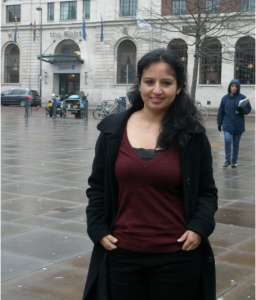I was worried about the thousands of children who no longer have the protection of their parents and comfort of life after the historic disaster. And as someone who has been advocating for increasing opportunities for Nepalese children to read, I was now left with an almost debilitating set of questions: read what? read how? read when and where? When food and shelter, pain and fear, and the care and perhaps presence of parents have disappeared for so many children across the country, how can I talk about reading and writing? And to add to the misery, we hear cases of rape, sexual harassment and theft. I may only be able to add a drop in the bucket, but I wanted to add that drop. I could not stay in my tent while it shook and return to my house when it stopped. I wanted to go where homes had collapsed, lives were shattered, children’s tender minds were shaken.

‘Finish your food, or I will call the police,” said a mother in our neighborhood to her four-year-old son on the first night in the shelter after the first earthquake. In the next couple of days, the traditional bogeyman of police, ghost, and teacher would be replaced by ‘earthquake’!
While my knowledge of child psychology is only based on experience and interest, I could see a contradiction in this situation. We were faced with the most traumatizing situation of our lifetime, but our society doesn’t seem to have a culture, tradition, of profession for dealing with psychological trauma and stress. What if we have a generation of psychologically impacted children? How is the disaster going to affect the education and careers of the next generation? What are the local resources and practices that we can build upon in order to mitigate trauma in children? How can we turn the disaster into a turning point, to recover and rebuild, and to inspire this traumatized generation to do great things?
I was worried about the thousands of children who no longer have the protection of their parents and comfort of life after the historic disaster. And as someone who has been advocating for increasing opportunities for Nepalese children to read, I was now left with an almost debilitating set of questions: read what? read how? read when and where? When food and shelter, pain and fear, and the care and perhaps presence of parents have disappeared for so many children across the country, how can I talk about reading and writing? And to add to the misery, we hear cases of rape, sexual harassment and theft. I may only be able to add a drop in the bucket, but I wanted to add that drop. I could not stay in my tent while it shook and return to my house when it stopped. I wanted to go where homes had collapsed, lives were shattered, children’s tender minds were shaken.
So, as soon as I had access to the internet and after informing friends and families about my safety, I set about researching material on what I believed was a blind spot in my society, the Post Traumatic Stress Disorder (PTSD). Meanwhile, I also wrote to friends in my close network, and shared some preliminary ideas for a possible project. I spent the first week finding out what organizations, experts and resources are available and who I could partner with. Also, with the help of my teacher/ friend/ mentor Shyam Sharma, who is currently a professor at an American university, I started a Facebook page named Saarathi (connotation: friend, from Sanskrit “charioteer”). Saarathi was able to successfully raise close to $1500 (our current goal is $2000) in less than a week!
After the Nepal government announced that all schools should resume from the first week of June, the schools were anxious about how to deal with students once they come back to school and how to deal with the questions that the students are likely to ask. Over 16,000 schools have been impacted. Save the Children estimates that 90% of schools have been flattened to the ground in Gorkha (the epicenter of the quake). The Government of Nepal mandated that schools reopen on May 30, 2015. There was an immediate need to train teachers and provide them with earthquake focused lesson plans to address the trauma that teachers and students carry into the classrooms before regular lessons resume. Therefore, Naulo Margha prepared a package of lesson plans that help schools ease students back into regular activities even as they resource them to cope with the inevitable trauma resulting from the earthquake. Around 100 trainers were trained to train another 2400 teachers in Kathmandu valley in just a week. Under the project, ‘Post Earthquake Relief Through Education: Training of Teachers’, we were then able to provide one day training to teachers and equip them with a five days’ lesson plan that they could use in their classes. It is wonderful to see many of the schools around Nepal have resumed and children are going to school even though they have to sit under tents all day since the school buildings no more exist.
This is challenging work but I feel very strongly that it must be done — children deserve to be brought back to normal routine life and they must be protected.
I am hopeful. I am already smiling with the children day after day.
—-
About the Author:
Anuradha Sharma, a graduate from the University of Central Lancashire, UK in Intercultural Business Communications, is a children’s story writer, and is currently working towards helping mitigate psychological trauma in children.
Elt journals